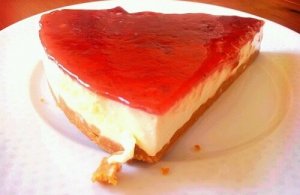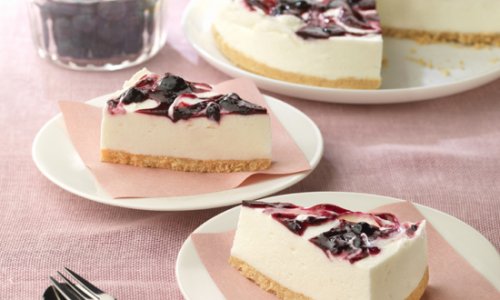Creamy Cheesecake with Philadelphia Cream Cheese

Today we’re bringing you this easy-to-make and delicious cheesecake recipe that is made with Philadelphia cream cheese instead of soft cheese, giving it a uniquely creamy texture and slightly sour kick!
You might like: How to Make a Blueberry Cheesecake
The other day I wanted to make cheesecake, but I hit a setback when I realized my scale wasn’t working properly. So, I had to improvise. I was lucky because I ended up with this great post about a brand-new recipe for cheesecake with Philadelphia cream cheese.
This recipe doesn’t contain any sort of weight measurements. Instead, I’m here to show you another way to measure for those of you who are too lazy to get the scale out.

Delicious Cheesecake with Philadelphia Cream Cheese
Ingredients (serves 4)
- 400 grams of Philadelphia cream cheese (if they come in units of 150 grams it’s fine to just use 3)
- A cup of sugar – 150 grams
- 1 cup of milk – 150 mL
- 4 overflowing tablespoons of flour – 80 grams
- 1 egg
- 1 cup of melted butter – 150 grams
Ingredients for the crust
- 1 packet/tube of tea biscuits
- 1½ cups of milk
Directions
We will start by preparing the crust so that we can focus on the cheese part as it bakes.
- First, prepare the mold for the tart. The chosen mold or pan should be greased or buttered first and then sprinkled lightly with flour in order to prevent the crust from sticking.
- Heat the cup and a half of milk and pour it into a large bowl. Break the cookies up into the milk and allow them to sit for a few minutes in order to absorb the milk.
- When the mixture seems to have become completely homogenous, press it into the mold in as even a layer as possible.
- Bake for 8 minutes at 300 degrees Fahrenheit.
Next, we will prepare the cheesecake itself.
- Beat the egg in a large bowl. Make sure to fully melt the butter (you can use the microwave or the stove) and add it and the sugar to the mixture. Beat the mixture with a whisk until even.
- Add the Philadelphia cream cheese, flour, and milk. Once the mixture has thickened, the help of an electric mixer will probably be required in order to ensure no lumps remain in the mixture
- Pour the mixture into the mold with the pre-prepared crust and bake for about 30 minutes at 330 degrees.
- Check to see if the cake is ready by inserting a knife or fork to see if it comes out clean. If not, put it back in the oven for another 10 minutes at a low temperature or with the oven turned off.
- When the cake is ready, let it cool. Once cooled, cover the top with a thin layer of blueberry or raspberry jam.
This cheesecake with Philadelphia cream cheese isn’t exactly traditional, but it’s easy and fun! It will satisfy your craving for cheesecake while at the same time introducing you to new ways of preparing desserts. You won’t have to use a scale for this cheesecake with Philadelphia cream cheese, so enjoy your lazy dessert!
Image courtesy of Rafel Miro
All cited sources were thoroughly reviewed by our team to ensure their quality, reliability, currency, and validity. The bibliography of this article was considered reliable and of academic or scientific accuracy.
- Casarrubios, M., y Armendariz J.L. Elaboraciones de pastelería y repostería en cocina. Ediciones Paraninfo, SA, 2013.
- Gisslen, W., y Antillón, H. Panadería y repostería para profesionales. No. 664.752 G57 2013.. 2001.
- Marín, C., and Y. Cárdenas. “Procesos básicos de pastelería y repostería.” Editorial Brief, Valencia-España 39 (2013): 43-44.
- Fundación Española de Nutrición. Huevo. http://www.fen.org.es/mercadoFen/pdfs/huevos.pdf
- Fundación Española de Nutrición. Leche entera. http://www.fen.org.es/mercadoFen/pdfs/lecheentera.pdf
This text is provided for informational purposes only and does not replace consultation with a professional. If in doubt, consult your specialist.








